2013: SHALE OIL WIPES OUT CANADIAN TOWN !
Cenovus Bakken Frac’d Crude (with toxic mystery frac chemicals, known carcinogen benzene and deadly H2S – vapour phase may contain higher concentrates) is more flammable than gasoline
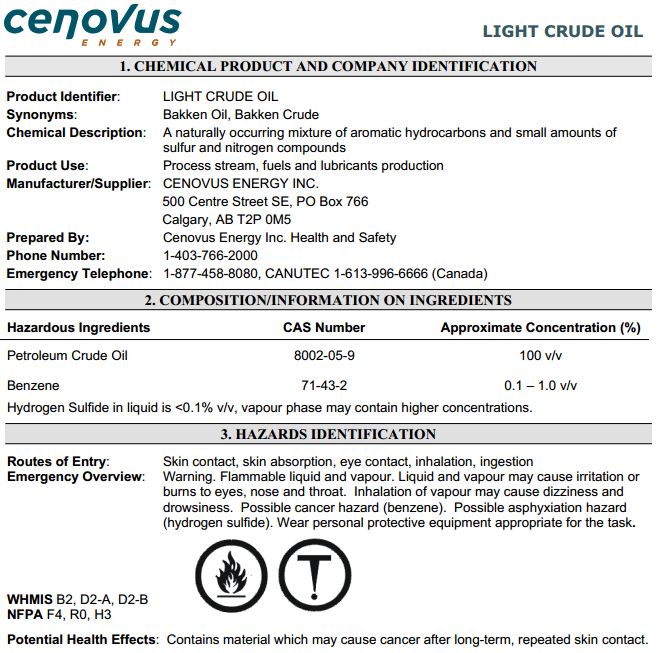
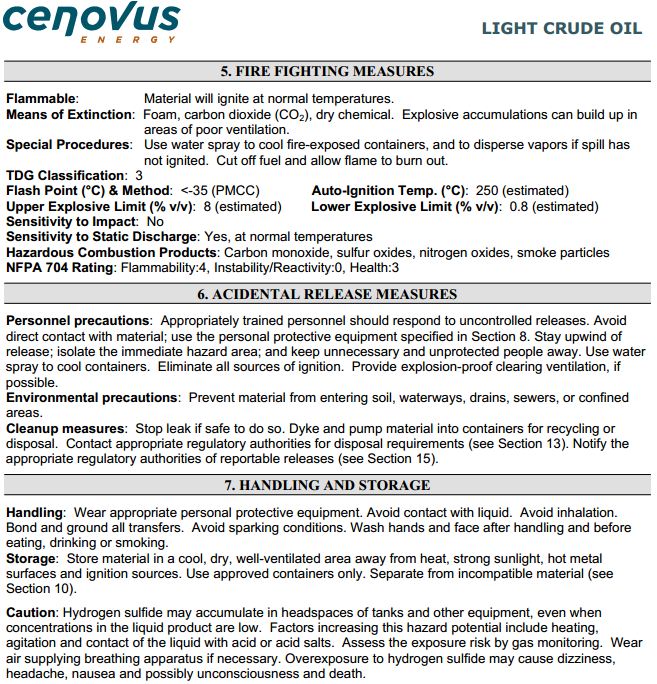
Study shows Lac-Mégantic disaster left fish in Chaudière River with major anomalies
Saskatchewan derailment: More rail restrictions after 1.2M litres of oil spill by Kelly Geraldine Malone, The Canadian Press, February 11, 2020, Calgary Herald
GUERNSEY, Sask. — Both of Canada’s major railways are restricting permits for shipping dangerous goods after a fiery train derailment last week in Saskatchewan that spilled about 1.2 million litres of oil.
The province’s Environment Ministry confirmed the amount of the spill in an email Tuesday. It said it was still being determined how much oil was recovered, but noted a significant portion had burned off.
Some 32 of 104 cars derailed and a dozen caught fire when a CP freight train jumped the tracks near Guernsey, about 115 kilometres southeast of Saskatoon, last Thursday.
Flames and thick black smoke poured from the crumpled train cars and 85 residents had to evacuate the area for more than 24 hours.
The rail line was reopened Friday.
Reeve Jack Gibney of the Rural Municipality of Usborne, which includes Guernsey, said there is concern in the agriculture community over the second major oil spill in two months.
Another derailment in December about 10 kilometres away on the same set of tracks also caused a fire when 1.5 million litres of oil spilled.
The rural municipality was to meet with CP officials Wednesday.
Local leaders have said people are worried about the safety of rail transport for oil and have suggested it’s time to look to pipelines. Trains, often carrying oil and other dangerous goods, move through the Saskatchewan hamlet every hour, Gibney has said.
After last week’s derailment, the federal government ordered lower speed limits for all trains carrying large amounts of dangerous goods.
In response, Canadian Pacific Railway and Canadian National Railway informed customers that they are limiting permits for shipments of dangerous goods, such as oil.
A bulletin from CP to its customers on Sunday said it would start limiting the permits Wednesday.
“We do not take these measures lightly and while it is too soon to quantify the impact, these actions are necessary given the multitude of variables and interdependencies involved in network operations,” John Brooks, CP’s chief marketing officer, said in the memo.
Shippers should not react by adding more private rail cars, because that would impede recovery, he added.
Protests over a major natural gas pipeline project in British Columbia are also affecting the country’s rail network. CN said blockades on its lines could lead to the rail carrier closing significant parts of its network.
Remediation efforts are underway at the site of the most recent derailment in Saskatchewan, the provincial government said.
The Transportation Safety Board said Tuesday that its investigators continue to work at the site. CP said in an emailed statement that crews were working to ensure the area was cleaned up and restored.
CP has contracted environmental consultants and contractors to assess any environmental impacts. The province said the rail company is responsible for all costs associated with the derailment, emergency response and remediation.
Cleanup is expected to take several months.
The province said the spill was fully contained to railway and highway ditches, and the frozen ground helped reduce the risk of contaminants penetrating too far down.
CP has also confirmed the tank cars involved were TC-117J types, which became the industry standard following the phaseout of the DOT-111 cars involved in the deadly rail disaster in Lac-Megantic, Que., in 2013. Forty-seven people were killed when tanker cars loaded with crude oil derailed and caused an explosion.
The TC-117 cars have additional safety features including thicker steel and thermal protection. [Those features appear mighty useless, don’t they?]
A retrofitted version of the TC-117 tank type was involved in crashes and subsequent oil leaks in the December derailment in Saskatchewan, as well as in other recent accidents in St. Lazare, Man., Iowa and Texas. It has a thinner shell than newer models.
1.2M litres of oil spilled in Guernsey, Sask. CP train derailment by Kelly Geraldine Malone, Feb 11, 2020, The Canadian Press in Global News
The Saskatchewan government says about 1.2 million litres of oil spilled during a fiery train derailment in a rural area last week.
The amount of oil recovered is still being determined, but a significant portion was burned off, the province’s Environment Ministry said in an email Tuesday.
The Canadian Pacific Railway freight train jumped the tracks near Guernsey, about 115 kilometres southeast of Saskatoon, early Thursday. Thirty-two of the train’s 104 cars derailed and a dozen caught fire.
Flames and thick black smoke poured from the crumpled train cars and prompted an evacuation of about 85 residents from the area for more than 24 hours.
Reeve Jack Gibney of the Rural Municipality of Usborne, which includes Guernsey, said there is concern in the agriculture community over the second major oil spill in two months.
Another derailment in December about 10 kilometres away on the same set of tracks also caused a fire when 1.5 million litres of oil spilled.

The rural municipality is to meet with CP officials Wednesday.
Remediation efforts were already underway at the site of the most recent derailment, the province said. The rail line was re-opened on Friday.
The Transportation Safety Board said Tuesday that its investigators were continuing to work at the site. CP said in an emailed statement that crews were working to ensure the area was cleaned up and restored.
CP has contracted environmental consultants and contractors to assess any environmental impacts. The province said the rail company is responsible for all costs associated with the derailment, emergency response and remediation.
Cleanup is expected to take several months.
The province said the spill was fully contained to railway and highway ditches, and the frozen ground helped reduce the risk of contaminants penetrating too far down.
Local officials have said there is concern over the safety of rail transport for oil and have suggested it’s time to look to pipelines. Trains, often carrying oil and other dangerous goods, move through the Saskatchewan hamlet every hour, Gibney said.
After last week’s derailment, the federal government ordered lower speed limits for all trains carrying large amounts of dangerous goods.
CP has also confirmed the tank cars involved were TC-117J types, which became the industry standard following the phase-out of the DOT-111 cars involved in the deadly rail disaster in Lac-Megantic, Que., in 2013. Forty-seven people were killed when tanker cars loaded with crude oil derailed and caused an explosion.
The TC-117 cars have additional safety features including thicker steel and thermal protection.
A retrofitted version of the TC-117 tank type was involved in crashes and subsequent oil leaks in the December derailment in Saskatchewan, as well as in other recent accidents in St. Lazare, Man., Iowa and Texas. It has a thinner shell than newer models.
Minister orders slowdown after second train carrying oil derails in Saskatchewan by Kelly Geraldine Malone and Steve Lambert, The Canadian Press, February 6, 2020
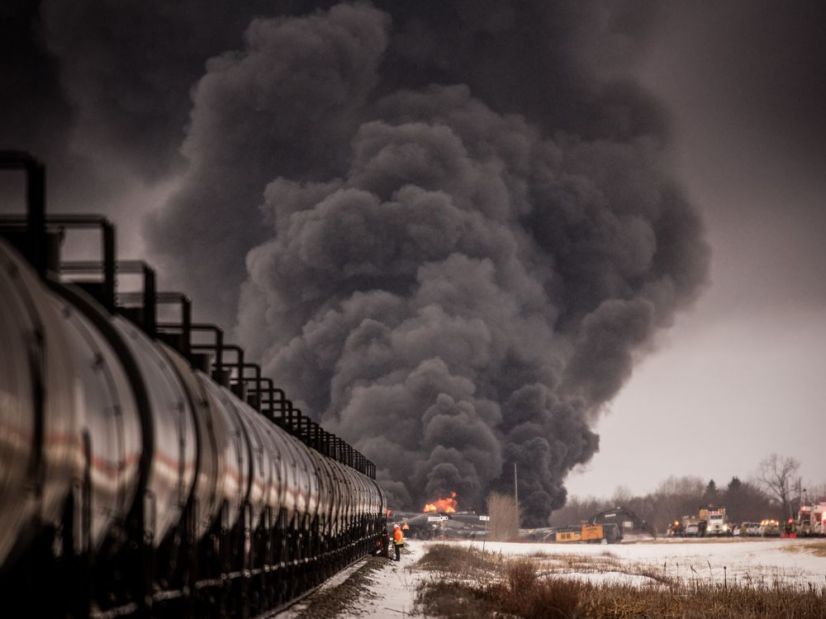
Smoke billows up from a derailed Canadian Pacific Railway train near Guernsey, Sask., on Thursday, Feb. 6, 2020. MATT SMITH / THE CANADIAN PRESS
GUERNSEY, Sask. — The federal government on Thursday ordered lower speed limits for all trains carrying large amounts of dangerous goods, hours after a fiery derailment in rural Saskatchewan sent thick black smoke into the air.
A Canadian Pacific Railway freight train carrying crude oil jumped the tracks about 6:15 a.m. near Guernsey, 115 kilometres southeast of Saskatoon. Thirty-one of 104 cars derailed and a dozen caught fire, the Saskatchewan Public Safety Agency said.
It also said there were no injuries.
“It looks like the back third of the train (derailed) and … (there’s)heavy, heavy smoke,” said Blaine Weber, who lives in nearby Lanigan.
“There’s probably at least 15, 20 cars … all stacked up on the crossing that comes off the Yellowhead Highway.”
A pillar of dark smoke continued to billow from the flaming wreckage well after daybreak.
Jack Gibney, reeve of the Rural Municipality of Usborne, which includes Guernsey, said about 85 residents were evacuated from homes in the agricultural community. The hamlet is surrounded by farmland and is near a potash mine operated by Nutrien.
Tom Lukiwski, the member of Parliament for the area, said he was shocked to learn the derailment was the second to happen on the same stretch of rail within two months.
About 19 cars on another CP train ran off the tracks Dec. 9 about 10 kilometres to the west, causing a major blaze and leaking 1.5 million litres of oil.
“To have two major derailments that are incredibly serious, is something that is almost incomprehensible,” Lukiwski said. “I am not a big believer in coincidence, and this seems to be that it’s more than just coincidence.”
Transport Minister Marc Garneau said the ministerial order requires trains carrying 20 or more cars of dangerous goods to travel at lower speeds while the crash is investigated.
“That speed reduction will require them to go at no more than 25 miles (40 kilometres) per hour across the country except … 20 miles (32 kilometres) per hour in built-up metropolitan areas,” Garneau said in Ottawa. Those speed limits are half as fast as limits currently listed on Transport Canada’s website.
“This will be put into effect for the next 30 days. We could shorten that — we’re looking for the causes to see if there is a common pattern — or we could lengthen it depending on how things are progressing,” he said.
“I realize there will be an effect on the economy of the country because our trains move important goods … but it is very, very important that we not sacrifice safety.” [Too late, many sickened and killed already in Canada by this greedy industry and it’s incestuous enablers]
Transportation Safety Board investigators were heading to the site.
CP Rail said it supports the new speed limits.
“Until we better understand the facts relating to today’s incident, it is prudent to operate with an abundance of caution,” CP president Keith Creel said in a written statement. The company also promised to clean up the area and to help evacuees.
Patty Prentice was driving to work just after the derailment and, in the pre-dawn darkness, initially thought she was coming across a small fire.
“The flames just got bigger and bigger and I could feel the heat when I drove by,” Prentice said.
She said she called relatives who also live in the area and heard they were told to get out. “They knocked on doors, told them … to meet at the community centre if they wanted to know more information.”
The section of the Yellowhead Highway, a major route through Western Canada, was closed in both directions.
RCMP allowed through a couple of semi-trailers and front-end loaders, which were being used to put out the flames.
Weber said he wants answers on why there have been two recent derailments in the area.
“I’m really, really concerned about the seeming lack of accountability.”
[The lack of accountability in the oil patch in Canada is not “seemingly.” It happens every day, has been for decades and was intentionally set up by our politicians and regulators to be so, for obvious reasons. Our politicians – federal, provincial and municipal -know it.]
2020 02 06: Federal transport minister orders trains to slow down after fiery crash in Sask., ‘I cannot compromise on safety,’ Marc Garneau says [Ya, right, how soon after the fire is out, will he wink wink, and rescind his order? Oil patch will never let any politician or regulator in North America slow down their rabid greed]
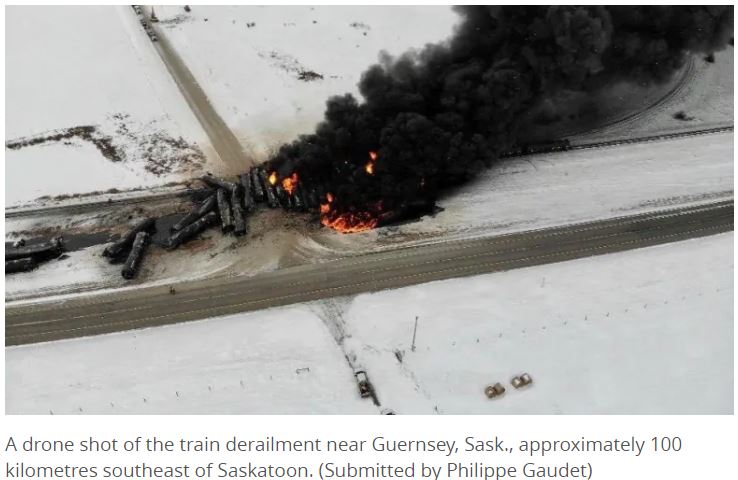
“Like, what the heck is going on?”
[What’s going on? Oil and gas companies their regulators and our politicians, don’t give a damn about public health or safety, their workers, or our communities, farms, air, land, water, food, they only care about more money and lies.]

Derailed Sask. CP train leaked more than 6 times the amount of oil than 2016 Husky pipeline spill An estimated 1.5 million litres of crude oil leaked from the train, the TSB says
… The university’s journalism department recently compiled a map of Saskatchewan spills from 2000 to 2018. It pinpointed 14,958 oil and gas industry spills during that period, including the release of 59 million litres of oil.
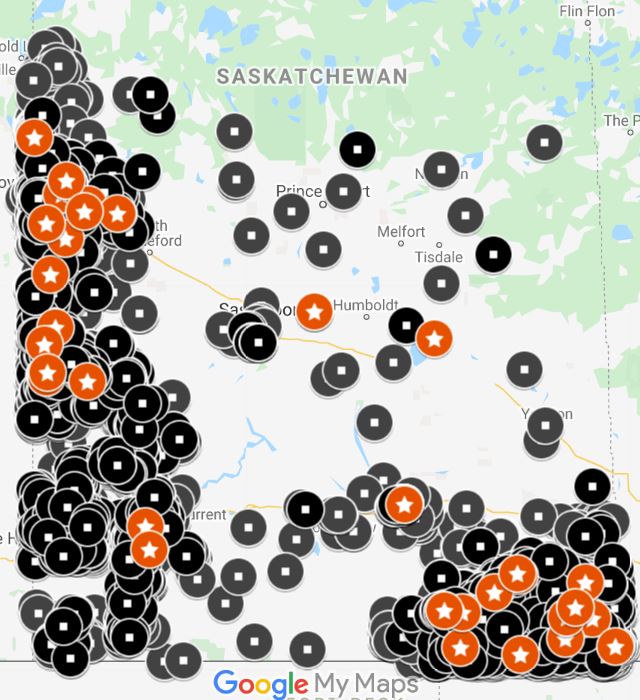
… Of the 33 derailed cars — which ended up in a large pile over some 500 metres — about 20 were breached and spilled out product that became engulfed in flames that burned for about 24 hours.
About 19 of the oil tank cars lost their entire loads. … The leaks came despite the use of tanks…meant to protect against such punctures and damage in the case of a crash or fire.
… After the July 2013 Lac-Mégantic frac’d crude oil train crash that killed 47 people, the federal government unveiled the rail cars it hoped would become the new standard for transporting flammable liquids. Dubbed the TC-117 in Canada (DOT-117 in the U.S.), these cars have better thermal protection and are supposed to withstand puncture and other damage better than their predecessors, according to Transport Canada.
… Transport Canada, which is monitoring the TSB’s investigation, says it has taken steps in recent years to make railways safer. “Only the most crash-resistant tank cars available are allowed to be used to transport crude oil in Canada,” a spokesperson said Thursday. [Sure aren’t crash resistant are they]
